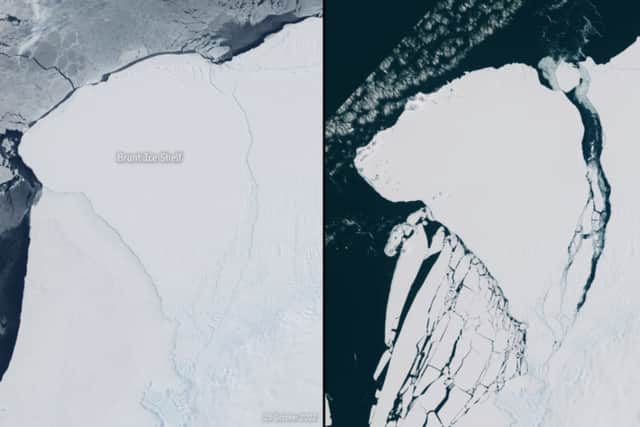Iceberg the size of London: Antarctica iceberg breaks off from Brunt Ice Shelf - is Halley Research Station safe?
and live on Freeview channel 276
An iceberg nearly the size of Greater London has broken off the Brunt Ice Shelf in Antarctica.
According to the British Antarctic Survey, the “calving” event on Sunday (22 January) resulted in an iceberg roughly 600 square miles in size. Researchers say the incident was a natural, expected occurrence, and was not brought on by climate change.
Advertisement
Hide AdAdvertisement
Hide AdScientists initially identified as having significant cracks in the ice shelf a decade ago, but in the past two years, there have been two major breaks.
Here is everything you need to know about it.
Is the Halley Research Station safe?
Glaciologists said the BAS Halley Research Station, which is situated on the Brunt Ice Shelf, is safe. The research station was established in 1956 to study the Earth’s atmosphere, and measurements from Halley led to the discovery of the ozone hole in 1985.
The current base was built with architectural features designed to overcome the difficulty of construction on a floating ice shelf without being buried and crushed by snow.
Was the new iceberg caused by climate change?


The recent calving incident was a natural occurrence that was expected and was not caused by climate change, according to researchers.
Advertisement
Hide AdAdvertisement
Hide Ad“This calving event has been expected and is part of the natural behaviour of the Brunt Ice Shelf,” said Professor Dominic Hodgson, a BAS glaciologist, in a press release. “It is not linked to climate change.”
The iceberg drifted away from the west side of the continent on Sunday. Years of cracking caused by the tidal swell of the oceans led to its breakaway.
“Our science and operational teams continue to monitor the ice shelf in real-time to ensure it is safe, and to maintain the delivery of the science we undertake at Halley.”
The extent of the sea ice in Antarctica is highly unpredictable, in contrast to the Arctic, where scientists believe that climate change is hastening its decline.
Advertisement
Hide AdAdvertisement
Hide Ad“There’s a link between what’s going on in Antarctica and the general warming trend around the rest of the world, but it’s different from what we see in mountain glaciers and what we see in the Arctic,” Ted Scambos, a glaciologist and lead scientist at the National Snow and Ice Data Center told CNN.
As recently as 2014 and 2015, the region was still producing record-high sea ice extent, according to satellite data going back to 1978. It then abruptly decreased in 2016, and has remained below normal ever since.
At the end of December 2022, Antarctic sea ice extent was at its lowest point in the 45-year satellite record, according to a report published by scientists at the National Snow and Ice Data Center.
"While the decline in Antarctic sea ice extent is always steep at this time of year, it has been unusually rapid this year," they added.
Advertisement
Hide AdAdvertisement
Hide AdA wide band of warmer-than-average air temperatures, which rose to two degrees Celsius above average in November and December, has contributed to the thin sea ice, a loss of which has also been accelerated by strong winds.
Comment Guidelines
National World encourages reader discussion on our stories. User feedback, insights and back-and-forth exchanges add a rich layer of context to reporting. Please review our Community Guidelines before commenting.
